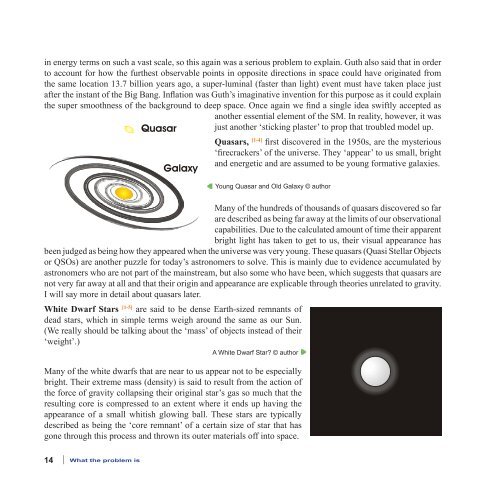A Beginner's View of Our Electric Universe - New
A Beginner's View of Our Electric Universe - New
A Beginner's View of Our Electric Universe - New
Create successful ePaper yourself
Turn your PDF publications into a flip-book with our unique Google optimized e-Paper software.
in energy terms on such a vast scale, so this again was a serious problem to explain. Guth also said that in order<br />
to account for how the furthest observable points in opposite directions in space could have originated from<br />
the same location 13.7 billion years ago, a super-luminal (faster than light) event must have taken place just<br />
after the instant <strong>of</strong> the Big Bang. Inflation was Guth’s imaginative invention for this purpose as it could explain<br />
the super smoothness <strong>of</strong> the background to deep space. Once again we find a single idea swiftly accepted as<br />
another essential element <strong>of</strong> the SM. In reality, however, it was<br />
just another ‘sticking plaster’ to prop that troubled model up.<br />
Quasars, [1-4] Quasar<br />
first discovered in the 1950s, are the mysterious<br />
‘firecrackers’ <strong>of</strong> the universe. They ‘appear’ to us small, bright<br />
and energetic and are assumed to be young formative galaxies.<br />
Galaxy<br />
Many <strong>of</strong> the hundreds <strong>of</strong> thousands <strong>of</strong> quasars discovered so far<br />
are described as being far away at the limits <strong>of</strong> our observational<br />
capabilities. Due to the calculated amount <strong>of</strong> time their apparent<br />
bright light has taken to get to us, their visual appearance has<br />
been judged as being how they appeared when the universe was very young. These quasars (Quasi Stellar Objects<br />
or QSOs) are another puzzle for today’s astronomers to solve. This is mainly due to evidence accumulated by<br />
astronomers who are not part <strong>of</strong> the mainstream, but also some who have been, which suggests that quasars are<br />
not very far away at all and that their origin and appearance are explicable through theories unrelated to gravity.<br />
I will say more in detail about quasars later.<br />
White Dwarf Stars [1-5] are said to be dense Earth-sized remnants <strong>of</strong><br />
dead stars, which in simple terms weigh around the same as our Sun.<br />
(We really should be talking about the ‘mass’ <strong>of</strong> objects instead <strong>of</strong> their<br />
‘weight’.)<br />
Many <strong>of</strong> the white dwarfs that are near to us appear not to be especially<br />
bright. Their extreme mass (density) is said to result from the action <strong>of</strong><br />
the force <strong>of</strong> gravity collapsing their original star’s gas so much that the<br />
resulting core is compressed to an extent where it ends up having the<br />
appearance <strong>of</strong> a small whitish glowing ball. These stars are typically<br />
described as being the ‘core remnant’ <strong>of</strong> a certain size <strong>of</strong> star that has<br />
gone through this process and thrown its outer materials <strong>of</strong>f into space.<br />
14 | What the problem is<br />
Young Quasar and Old Galaxy © author<br />
A White Dwarf Star? © author


